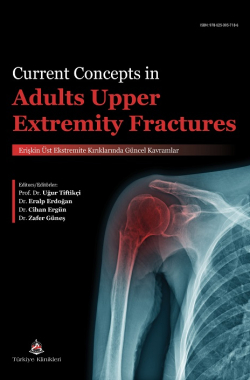SHOULDER CAPSULE AND LIGAMENT INJURIES: TREATMENT AND REHABILITATION
Tolgahan Cengiz1 Ahmet Ersoy2 Ercan Bayar3 Furkan Erdoğan4
1Kastamonu İnebolu State Hospital, Department of Orthopedics and Traumatology, Kastamonu, Türkiye
2Tokat Turhal State Hospital, Department of Orthopedics and Traumatology, Tokat, Türkiye
3Kastamonu Tosya State Hospital, Department of Orthopedics and Traumatology, Kastamonu, Türkiye
4Samsun Ondokuz Mayıs University, Faculty of Medicine, Department of Orthopedics and Traumatology, Samsun, Türkiye
Cengiz T, Ersoy A, Bayar E, Erdoğan F. Shoulder Capsule and Ligament Injuries: Treatment and Rehabilitation. In: Tiftikçi U, Erdoğan E, Ergün C, Güneş Z, editors. Current Concepts in Adults Upper Extremity Fractures. 1st ed. Ankara: Türkiye Klinikleri; 2025. p.63-68.
ABSTRACT
Shoulder injuries, particularly those affecting the rotator cuff, subacromial bursa, and joint stability, are common and can significantly impact functionality and quality of life. This section reviews the significant pathologies, such as rotator cuff tears and shoulder instability, detailing their mechanisms, diagnostic methods, and treatment strategies. Rotator cuff injuries usually occur as a result of degenerative changes or trauma and may require surgical intervention, usually in older individuals. Subacromial impingement syndrome complicates the picture with pain during overhead activities. Shoulder instability is classified as anterior, posterior, or multidirectional and may require treatment ranging from rehabilitation to surgical stabilization techniques, depending on its severity and nature. SLAP lesions are injuries affecting the upper labrum and can cause persistent shoulder pain. Diagnostic imaging, particularly magnetic resonance imaging (MRI), is critical in accurately identifying these conditions. Treatment begins with conservative methods, such as physical therapy and anti-inflammatory medications, depending on the severity of the disease, and may progress to surgical options when necessary. This comprehensive review highlights the importance of individualized rehabilitation strategies to optimize recovery and restore shoulder function in affected individuals..
Keywords: Rotator cuff; Shoulder instability; Impingement; SLAP lesions; Rehabilitation
Kaynak Göster
Referanslar
- Miller MD, Thompson SR. Miller's review of orthopaedics: Elsevier Health Sciences.
- Rockwood CA, Wirth MA, Fehringer EV. Rockwood and Matsen's The Shoulder E-Book: Elsevier Health Sciences. 2016.
- Karademir Gökhan AAC. Omuzda Sık Görülen Rahatsızlıklar. In: Bombacı H, editor. TOTDER Ortopedi ve Travmatoloji.
- Bushnell BD, Anz AW, Bert JM. Venous thromboembolism in lower extremity arthroscopy. Arthroscopy: The Journal of Arthroscopic & Related Surgery. 2008;24(5):604-11. [Crossref] [PubMed]
- Çetinkaya m, Özer M. Sports Related Shoulder Injuries. 2015;726-41. [Crossref]
- Ulunay K. Omuz Artroskopisi: Azim Matbaacılık. 2015.
- Demirtaş M, Armangil M, Bezirgan U. Posterior omuz instabilitesi. TOTBİD. (12):1. [Crossref]
- Antoniou J, Harryman DT. Posterior instability. Orthopedic Clinics. 2001;32(3):463-73. [Crossref] [PubMed]
- Neer 2nd C, Foster C. Inferior capsular shift for involuntary inferior and multidirectional instability of the shoulder. A preliminary report. JBJS. 1980;62(6):897-908. [Crossref]
- Yanmış İ. Çok Yönlü Omuz İnstabiliteleri 2013;12(4). [Crossref]
- Andrews JR, Carson JR WG, Mcleod WD. Glenoid labrum tears related to the long head of the biceps. The American journal of sports medicine. 1985;13(5):337-41. [Crossref] [PubMed]
- Snyder SJ, Karzel RP, Del Pizzo W, Ferkel RD, Friedman MJ. SLAP lesions of the shoulder. Arthroscopy: the journal of arthroscopic & related surgery. 1990;6(4):274-9. [Crossref] [PubMed]
- Maffet MW, Gartsman GM, Moseley B. Superior labrum-biceps tendon complex lesions of the shoulder. The American journal of sports medicine. 1995;23(1):93-8. [Crossref] [PubMed]
- Modarresi S, Motamedi D, Jude CM. Superior labral anteroposterior lesions of the shoulder: part 2, mechanisms and classification. American Journal of Roentgenology. 2011;197(3):604-11. [Crossref]

